Top 10 DAST Tools for DevSecOps in 2026: APIs, CI/CD & Business Logic
Discover the top 10 DAST tools for 2026, built for SPAs, APIs (REST, GraphQL...), business logic vulnerabilities, and CI/CD pipelines. Compare strengths, weaknesses, and key features that matter to AppSec and DevSecOps teams.

When it comes to securing applications and APIs, the best DAST tools are indispensable. These advanced solutions detect vulnerabilities by continuously scanning for weaknesses and simulating real-world attacks.
Modern DAST goes beyond surface-level checks. It identifies business logic flaws, broken authentication, and other issues that only emerge through actual interaction with an application’s exposed interfaces and workflows.
By focusing on how attackers could exploit intended functionality, modern DAST reduces false positives and adds critical security coverage - especially for teams adopting CI/CD pipelines and developer-first security programs.
Modern DAST tools are transforming application security by overcoming the pitfalls of legacy solutions like Qualys and Rapid7, which burden teams with false positives, manual setups, and limited remediation guidance. Instead, modern tools reduce workloads, minimize false positives, and integrate seamlessly into CI/CD pipelines.
"DAST is not dead, legacy DASTs are. Modern DASTs are changing the industry." - Swan Beaujard, Security Engineer at Escape, at the Elephant in AppSec Conference
What sets the top DAST tools apart is their adaptability and ability to automate manual tasks. They provide real-time feedback, freeing up security teams to focus on strategic priorities and scaling application security with limited resources.
This article explores the top DAST tools for DevSecOps, their pros and cons, and how they can help secure your applications and APIs as a critical part of your cybersecurity strategy.
Replace legacy DAST tools & scale your security testing
From business logic to complex authentication
TL;DR: Quick Overview of the Top 5 DAST Tools
Here is a list of the most explored in demos DAST tools for replacing legacy DAST or integrating new DAST into your AppSec program organized by features:
To sum it up, here is a presentation of each tool with its strengths and limitations:
| DAST Tool | Strengths | Limitations | Best For |
|---|---|---|---|
| Escape |
✅ Full API and web app scanning (both internal & external) ✅ Proprietary DAST algorithm with business-logic-aware attack scenarios ✅ Native GraphQL support and AI-powered proof of exploit and remediation |
Advanced security tests may require deeper configuration | Medium–large organizations with lean security teams and frequently deployed web apps and APIs or complex stacks; ideal also for Wiz users |
| StackHawk |
✅ Built on ZAP for strong web app and API security testing ✅ Excellent CI/CD integration and developer workflows |
⚠️ Limited reporting and remediation guidance ⚠️ May not scale for large enterprise needs |
Development and DevSecOps teams needing a continuous security solution |
| Bright Security |
✅ Strong security testing with a simple setup for predefined applications ✅ AI-powered remediation |
⚠️ Not API native ⚠️ Limited flexibility for custom tests |
Mid-sized teams looking for a strong DAST for pre-defined apps and good reporting |
| Invicti |
✅ Native DAST engine with strong web app support ✅ Rich reporting and executive summaries |
⚠️ Lacks detailed debugging and authentication verification ⚠️ Limited API support |
Large enterprises requiring thorough reporting and audit-ready output or an ASPM solution |
| Detectify | ✅ Good support for web apps via provided domains and connectors |
⚠️ Doesn't cover API testing ⚠️ Lacks support for complex scenarios & authentication |
Small–medium businesses seeking quick, lightweight vulnerability scanning |
Why legacy DAST tools don't work for DevSecOps
Legacy DAST tools often fall short when it comes to modern application security needs. They introduce challenges that hinder effective vulnerability detection and remediation, including:
- False Positives Overload: Endless false positives waste valuable time and cause critical vulnerabilities to be overlooked, leaving applications exposed.
- Manual Configurations: These tools demand time-consuming manual setups that struggle to integrate with CI/CD pipelines, making them unsuitable for scalable, modern development workflows.
- Developer Frustration: A lack of actionable remediation guidance creates friction with engineering teams, forcing developers to spend excessive time diagnosing and resolving issues instead of building features.
Modern applications are built around Single-Page Apps (SPAs) and APIs, which bring great flexibility but also introduce new challenges. Today's security threats include issues like Insecure Direct Object References (IDORs), Server-Side Request Forgery (SSRF), and Access Control vulnerabilities. Security needs to be efficient and scalable to stay ahead of these risks. With the fast-paced nature of agile development, security teams can no longer afford to work in isolation or reactively. Instead, they must automate security processes and integrate them seamlessly into a DevSecOps pipeline, making security a continuous, proactive part of development.
This is where the top DAST tools excel, addressing these limitations by reducing manual workload, minimizing false positives, and offering seamless CI/CD integration.
If you still don't know enough about Qualys DAST or Rapid7 InsightAppSec DAST, we put a brief recap at the bottom of this article.
Now, you can jump to the best DAST tools below.
Top 10 DAST Tools: A deep-dive
Escape DAST

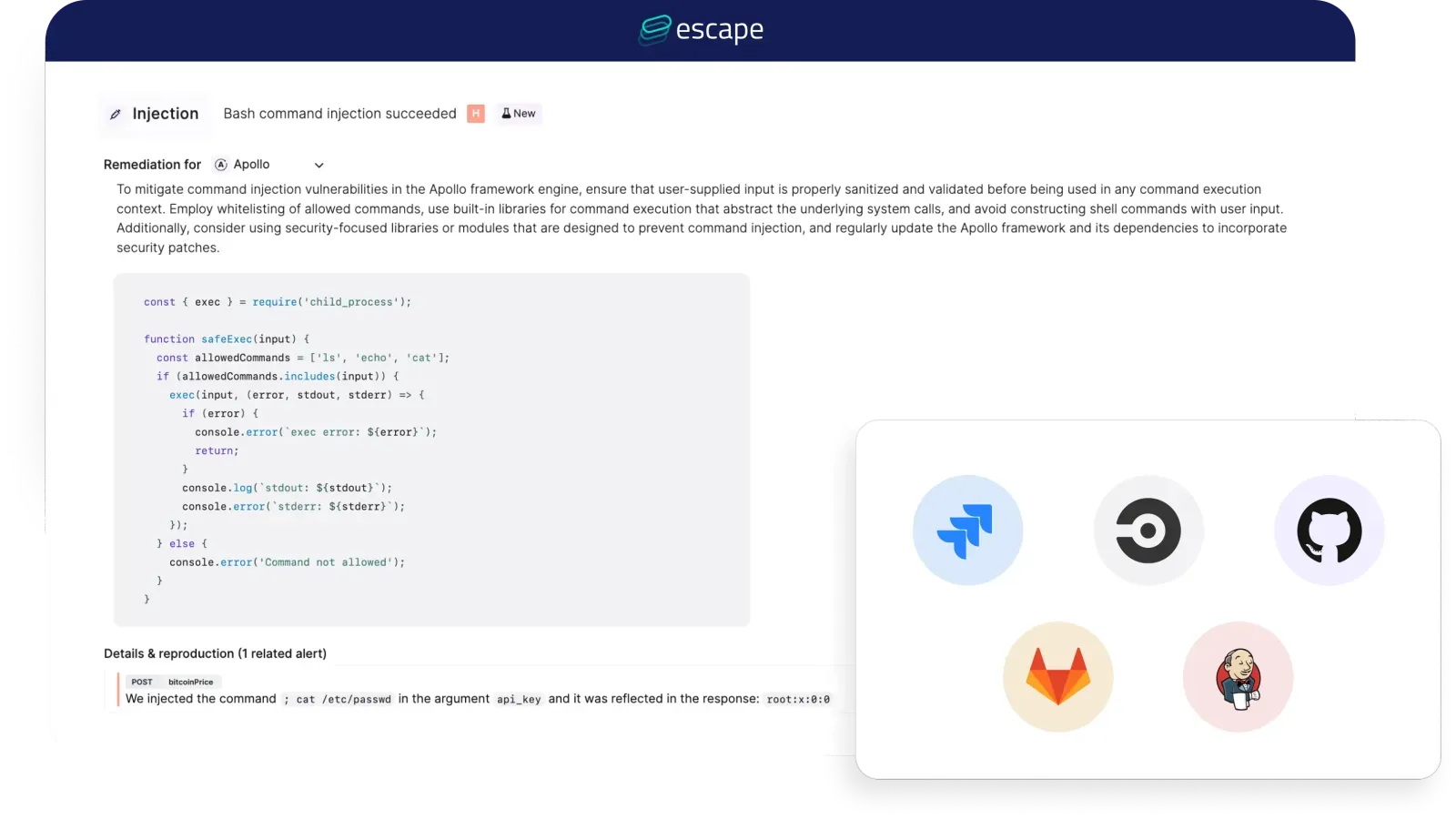
Overview:
Escape DAST - Best for Modern AppSec Teams: Securing modern web apps (e.g. SPAs) and APIs (REST, GraphQL..). Escape DAST is one of the most advanced Dynamic Application Security Testing (DAST) tools in 2026, built specifically for modern tech stacks and complex authentication workflows. It’s ideal for security and AppSec teams looking to scale vulnerability detection with minimal effort and high accuracy.
What sets Escape apart from traditional DAST tools is its ability to detect business logic vulnerabilities.
It’s the only DAST solution that uses a feedback-driven Business Logic Security Testing (BLST) engine. This enables deeper testing tailored to your unique app context, identifying vulnerabilities other scanners often miss. Special attention is given to real-world vulnerabilities like IDORs, BOLAs, and access control flaws. Each discovered vulnerability is supported by AI-Powered Exploit Validation.
In addition to security testing, Escape combines Attack Surface Management and agentless API discovery, and is the best DAST to handle complex authentication scenarios and multi-user testing with natural language rules.Escape is built to support Single Page Applications (SPAs), APIs natively, and to easily integrate in CI/CD pipelines.
🔍 Features
● In-depth Detection for Business Logic Flaws: Escape’s proprietary Business Logic Security Testing engine identifies deep business logic threats like BOLAs, IDORs, and others that often require human in the loop
● GraphQL-Native Security Testing: Escape is purpose-built for GraphQL, sending context-aware queries that reflect real application logic, uncovering vulnerabilities that legacy DAST tools miss.
● Complex authentication handling: Set up advanced authentication configurations, including multi-step auth flows or text-based CAPTCHA
● CI/CD-Ready Custom Tests: Define security rules that evolve with your web apps and APIs and run automatically in your CI/CD pipelines with no manual upkeep. See Escape Rules.
● Automated Asset Discovery, including agentless API discovery: Escape automatically detects external, internal and third-party web apps and APIs by scanning source code with no traffic capture or agents required. It also generates and maintains up-to-date API schemas without manual uploads.
● Risk-Based Vulnerability Prioritization: Escape ranks findings by business impact and exploitability, enabling focused remediation. Explore Prioritization Funnel.
● Developer-Centric Remediation: Escape auto-generates Jira tickets with remediation code tailored to your stack, helping developers fix vulnerabilities faster and reduce MTTR with less back and forth.
📊 Pros & Cons
| 📈 Pros | 📉 Cons |
|---|---|
|
✅ Ability to handle complex business logic vulnerabilities. Highly accurate request generation, enhanced by in-house generative AI for smarter vulnerability detection. ✅ Less than 3.7% false positive rate, reducing noise for security teams. ✅ Actionable remediation code snippets, accelerating patching and improving developer efficiency. ✅ Prioritizes critical applications by business context, data sensitivity, and external exposure risk. ✅ Support for complex authentication ✅ Seamless integration with modern DevSecOps tools and CI/CD pipelines for scalable security workflows. |
❌ Advanced features require security expertise or training for optimal use. ❌ Integration coverage for some operational tools is still being expanded. |
Invicti DAST (formerly Netsparker DAST)

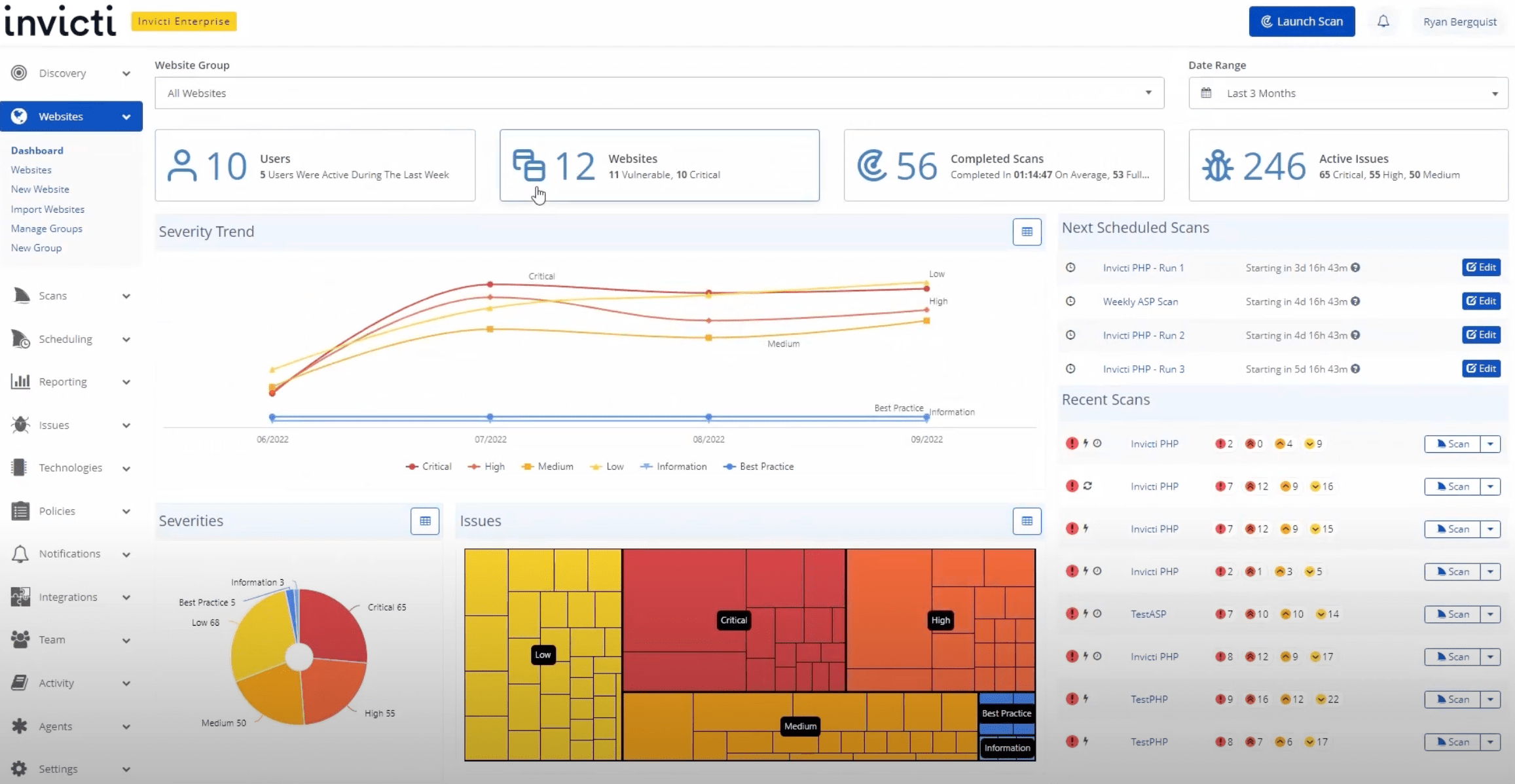
Overview:
Second in our list of the best DAST tools for 2026 is Invicti DAST, (formerly Netsparker DAST), a security solution built for scalable and automated vulnerability detection. Invicti combines Dynamic Application Security Testing (DAST) with Interactive Application Security Testing (IAST), making it capable of identifying a wide range of threats including SQL injection, XSS, misconfigurations, exposed databases, and out-of-band vulnerabilities.
Its automated crawler is designed to scan modern web technologies like HTML5, JavaScript-heavy applications, and Single Page Applications (SPAs). Invicti streamlines the process for development teams by automating crawling and vulnerability detection across complex web environments. While this DAST tool is best suited for large scale enterprises, Invicti also offers Acunetix a simplified version geared toward smaller organizations.
🔍 Features
● Fast vulnerability scans with live access to reports even before completion
● Highlights specific lines of code that require remediation
● Seamless integration with CI/CD pipelines, issue trackers, and Web Application Firewalls (WAFs)
● Basic scans can be completed within minutes for quick feedback cycles
📊 Pros & Cons
| 📈 Pros | 📉 Cons |
|---|---|
|
✅ Supports REST, SOAP, and GraphQL APIs (limited GraphQL coverage) along with traditional web applications. ✅ Generates detailed vulnerability reports for faster triage. ✅ Offers customizable security check templates to tailor DAST scans. ✅ Part of a broader security platform that includes IAST and Software Composition Analysis (SCA). |
❌ GraphQL testing is limited to basic vulnerability types. ❌ Primarily focused on web applications, with less coverage for modern cloud-native environments. ❌ Does not support automatic API specification generation, requiring manual uploads. ❌ Higher entry-level cost compared to other DAST tools in the market. |
StackHawk
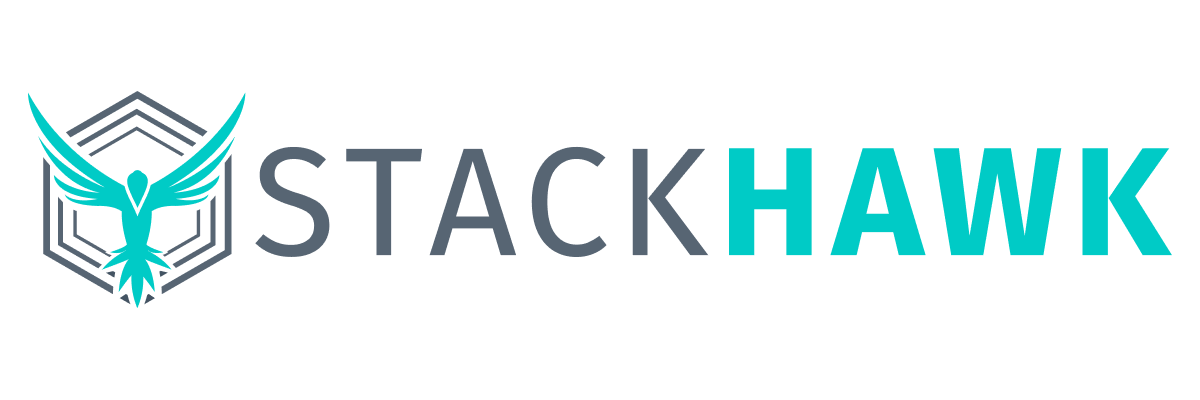
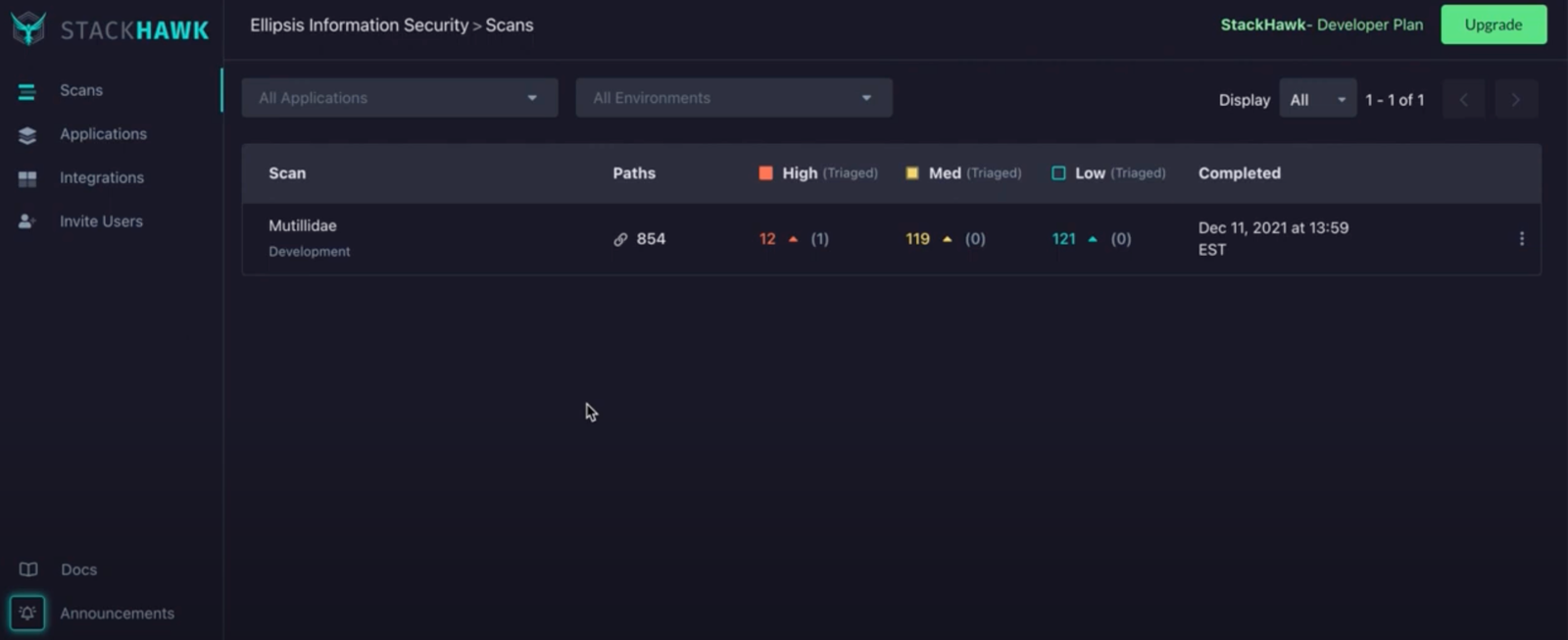
Overview:
StackHawk is a modern Dynamic Application Security Testing (DAST) tool built with developers in mind. It emphasizes catching security vulnerabilities early in the development lifecycle before code hits production. Designed for technical teams, StackHawk helps developers integrate security testing into continuous delivery pipelines with minimal disruption.
Its vulnerability prioritization follows the OWASP Risk Rating Methodology, focusing on impact and exploitability. StackHawk supports a wide range of API formats, including REST, GraphQL, SOAP, and gRPC, making it a solid DAST option for microservices-driven environments.
🔍 Features
● Enables developers to write custom test scripts for security scenarios not covered by default scans (built on the ZAP library)
● Supports parallel scanning across environments local dev, CI/CD pipelines, Kubernetes, or remote servers
● Offers automated and authenticated scans to detect vulnerabilities that appear only after login or session handling
📊 Pros & Cons
| 📈 Pros | 📉 Cons |
|---|---|
|
✅ Built for developers, with strong CI/CD integration ✅ Customizable attack templates to tailor security tests to business logic ✅ Flexible pricing tiers, ideal for startups and fast-growing teams |
❌ Built on ZAP, with limited support for detecting business logic vulnerabilities ❌ API schema uploads and configuration may require manual setup in complex apps ❌ Lacks deep remediation guidance for developers ❌ May not meet the scalability or feature depth needed by large enterprise teams |
Bright Security


Overview:
Bright Security stands out among modern DAST tools by embedding security testing directly into developer workflows. Its early stage testing capability starting within the IDE helps teams catch vulnerabilities before code ever reaches staging or production. This proactive approach enables faster, more secure releases without adding friction to development.
As one of the few developer first DAST tools, Bright integrates natively with popular CI/CD platforms like GitHub, GitLab, Jenkins, CircleCI, and JFrog. It detects critical web application vulnerabilities such as SQL injection, cross-site scripting (XSS), CSRF, and XXE, offering efficient, automated testing during every stage of delivery. While its coverage of business logic flaws is limited, Bright provides strong foundational testing with minimal configuration.
🔍 Features
● IDE-Based Security Testing: Run real-time attack simulations directly in the IDE to validate code and catch vulnerabilities early.
● CI/CD Pipeline Integration: Supports automated security testing across GitHub, GitLab, Jenkins, CircleCI, and TravisCI.
● Interactive Vulnerability Detection: Detects SQLi, CSRF, XSS, and XXE with limited business logic flaw coverage.
📊 Pros & Cons
| 📈 Pros | 📉 Cons |
|---|---|
|
✅ Quick setup and easy onboarding for engineering teams ✅ Developer-focused, with IDE-level security simulations ✅ Seamless CI/CD integration across major platforms |
❌ Requires manual API schema uploads before scans ❌ Remediation advice lacks depth across varied tech stacks ❌ Limited reporting capabilities for business-critical vulnerability prioritization |
Snyk(Probely)


Overview:
Snyk DAST (formerly Probely) is a cloud-based DAST tool geared toward straightforward application discovery and vulnerability scanning. It suits teams needing basic support for publicly accessible web apps without complex setup or deep security testing.
Snyk DAST performs standard DAST scans to identify common web vulnerabilities like XSS, SQL injection, and misconfigurations. Discovery relies on domain and DNS connectors (AWS Route 53, Cloudflare), but lacks source‑code or API schema automation. Testing APIs requires manual uploads, with no support for business logic flaws or internal assets. While the tool integrates with ticketing systems (e.g., DefectDojo), and offers remediation guidance, it doesn’t include framework‑specific fixes, code‑level remediation, or advanced findings.
Compare technical strengths of Escape vs Snyk DAST
🔍 Features
● Automated DAST Scanning: Performs classic dynamic application security testing (DAST) to identify common vulnerabilities like XSS, SQL injection, and misconfigurations in web applications.
● External Asset Discovery: Supports limited asset discovery via domain connections and DNS providers like AWS Route53 and Cloudflare, but lacks deep discovery from source code or internal environments.
● Manual API Testing Setup: Requires manual upload of API specifications to initiate scans, with no support for automated API discovery or modern API testing workflows.
● Basic DevSecOps Integration: Includes integration with popular CI/CD and ticketing tools, but lacks features like custom security rules, internal API scanning, or developer-focused remediation guidance.
● Backed by Snyk Ecosystem: Benefits from the broader Snyk platform, integrating DAST tools into a more comprehensive developer security solution.
📊 Pros & Cons
| 📈 Pros | 📉 Cons |
|---|---|
|
✅ Simple DAST setup for standard web app vulnerabilities ✅ Quickly integrates with ticketing and CI/CD systems ✅ Backed by Snyk’s wider security ecosystem |
❌ No native API discovery or automated schema generation ❌ Unable to test internal or VPN‑protected assets ❌ Does not detect business logic flaws or custom rules ❌ Requires manual API uploads for scanning ❌ Remediation lacks code‑level specificity and framework focus |
Burp Suite


Overview:
Burp Suite DAST is one of the more widely used DAST tools designed to test the security of modern web applications through both automated and manual methods. Known for its deep customization and flexibility, it enables technical teams to identify vulnerabilities such as SQL injection, XSS, and CSRF in dynamic environments.
Unlike simpler tools, Burp Suite DAST offers manual testing components alongside automated scans, making it a strong option for users with security expertise. While setup may be more involved, it remains a well-established dynamic application security testing (DAST) solution for teams needing both extensibility and precision.
🔍 Features
● Performs automated DAST scans to detect common web vulnerabilities like SQL injection, XSS, and CSRF.
● Allows manual security testing for complex scenarios, ideal for experienced security professionals.
● Supports advanced authentication workflows, including Basic Auth, JWT, session cookies, and login recording.
● Offers a flexible plugin system with both free and premium extensions for enhanced vulnerability detection and reporting.
● Includes manual testing tools like Burp Intruder, Repeater, and Sequencer for deep dynamic analysis and edge case testing.
📊 Pros & Cons
| 📈 Pros | 📉 Cons |
|---|---|
|
✅ Highly customizable, ideal for advanced users needing fine-tuned DAST testing capabilities ✅ Supports a wide range of authentication methods for complex login workflows ✅ Part of the Burp Suite ecosystem with a large user and plugin community |
❌ Requires manual testing expertise and tuning to deliver optimal results ❌ Lacks built-in support for automated GraphQL or modern API scanning ❌ Limited detection of business logic vulnerabilities ❌ Can be resource-heavy during extensive scans |
Intruder

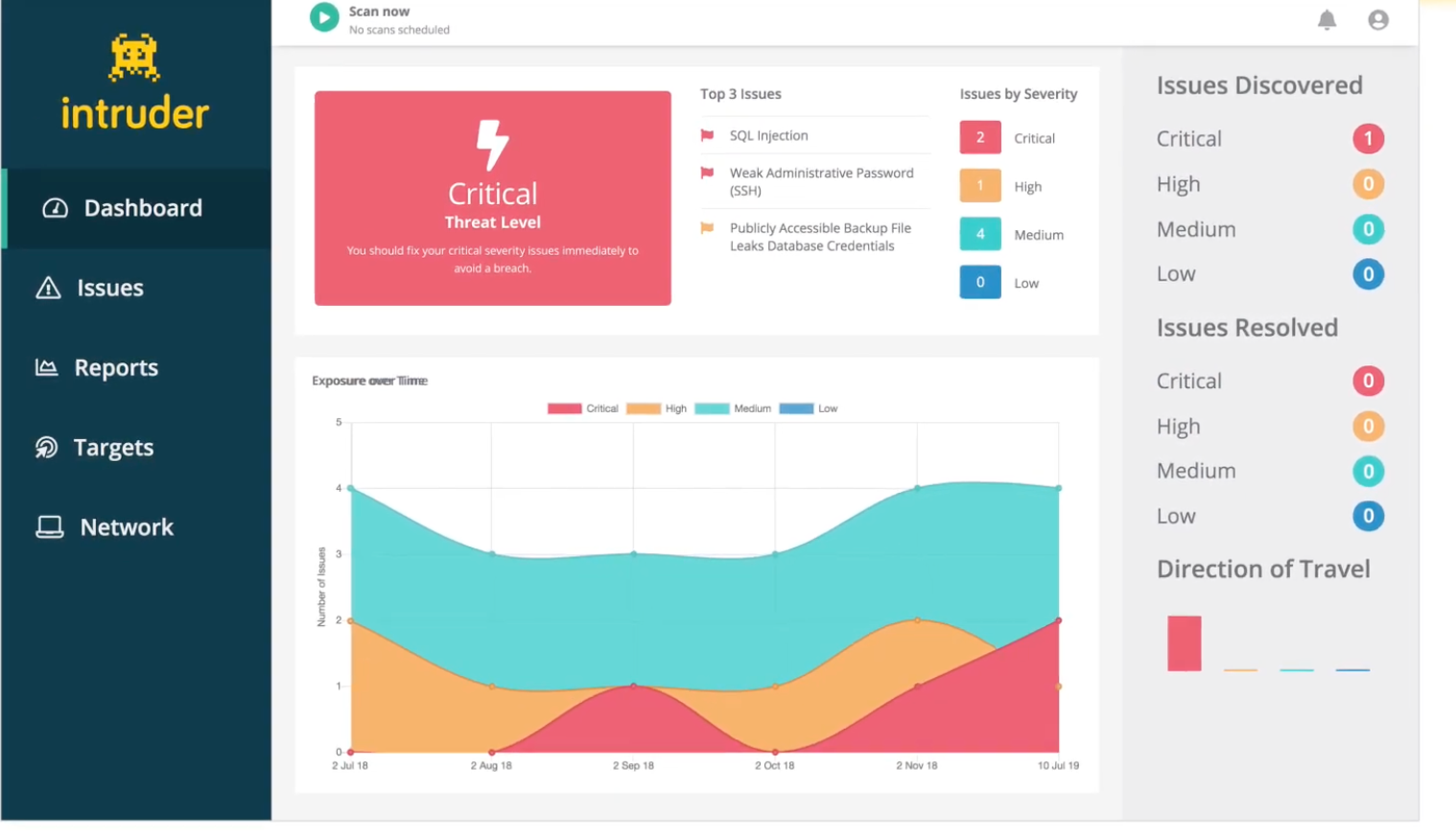
Overview:
Intruder is a cloud-based DAST tool designed for simplicity and wide-ranging coverage across web applications, APIs, and infrastructure. It excels in identifying exposed systems, misconfigurations, and known vulnerabilities with minimal configuration, making it a strong fit for SMBs and security aware development teams.
Unlike traditional enterprise tools, Intruder provides fast, automated security testing for both internal and external assets. It also includes manual black-box testing capabilities to support deeper assessments when needed.
🔍 Features
● Cyber Hygiene Score: Reflects an organization’s security posture by scoring how effectively vulnerabilities are managed useful for compliance and risk tracking.
● Extensive Integration Options: Supports tools like AWS, Azure, Google Cloud, Cloudflare, Jira, GitHub, GitLab, Teams, and Vanta, streamlining workflows across DevOps pipelines.
● Real-Time Vulnerability Alerts: Provides instant alerts when critical issues are detected, enabling fast response and reduced exposure.
● Audit-Ready Reports: Delivers compliance friendly reports for internal reviews, audits, and regulatory requirements.
📊 Pros & Cons
| 📈 Pros | 📉 Cons |
|---|---|
|
✅ Easy integration into CI/CD pipelines to align with DevOps practices ✅ Cost-effective DAST solution for individual users or growing teams ✅ Offers continuous vulnerability scanning and cloud security insights |
❌ Manual testing features may require expert involvement for full value ❌ Does not extend scanning to Kubernetes or advanced code-level analysis ❌ Lack of scan customization may reduce efficiency in complex environments |
Checkmarx


Overview:
Checkmarx is a security platform that combines Static and Dynamic Application Security Testing (SAST and DAST), offering a holistic solution for identifying vulnerabilities across the software development lifecycle. It performs DAST scans against live applications to uncover runtime risks, while also using SAST to detect issues in source code before deployment. This combined approach helps larger enterprises manage security at scale.Learn more about SAST vs DAST.
It supports the analysis of APIs, including REST, SOAP, and gRPC, making it suitable for complex applications with diverse architectures. While it’s powerful, Checkmarx requires a deeper investment in setup and resources, which aligns it more with larger organizations.
🔍 Features
● Performs SAST and DAST together for complete visibility across development and runtime environments.
● Integrates into CI/CD pipelines to automate testing before deployment stages.
● Supports automated testing of APIs and endpoints in live production environments.
● Correlates security findings across multiple layers: source code, APIs, open-source components, and infrastructure as code.
● Provides educational resources to help developers write secure code.
📊 Pros & Cons
| 📈 Pros | 📉 Cons |
|---|---|
|
✅ Combines multiple security testing methods (SAST, DAST, and SCA) into one platform ✅ Scalable architecture and flexible configurations for large enterprise environments ✅ Supports integration with common CI/CD tools and developer workflows |
❌ Requires considerable expertise and setup time for effective implementation ❌ Limited support for GraphQL API security testing ❌ Complex user interface may pose challenges for usability ❌ Higher potential for false positives compared to specialized DAST tools ❌ Custom rule configuration can be difficult to manage |
Fortify
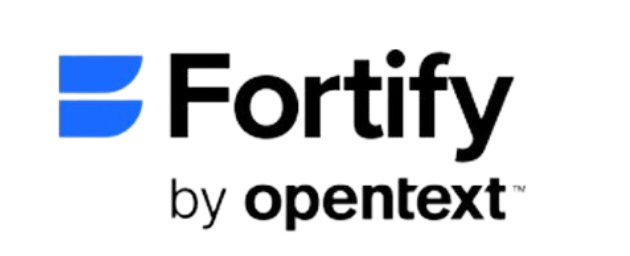
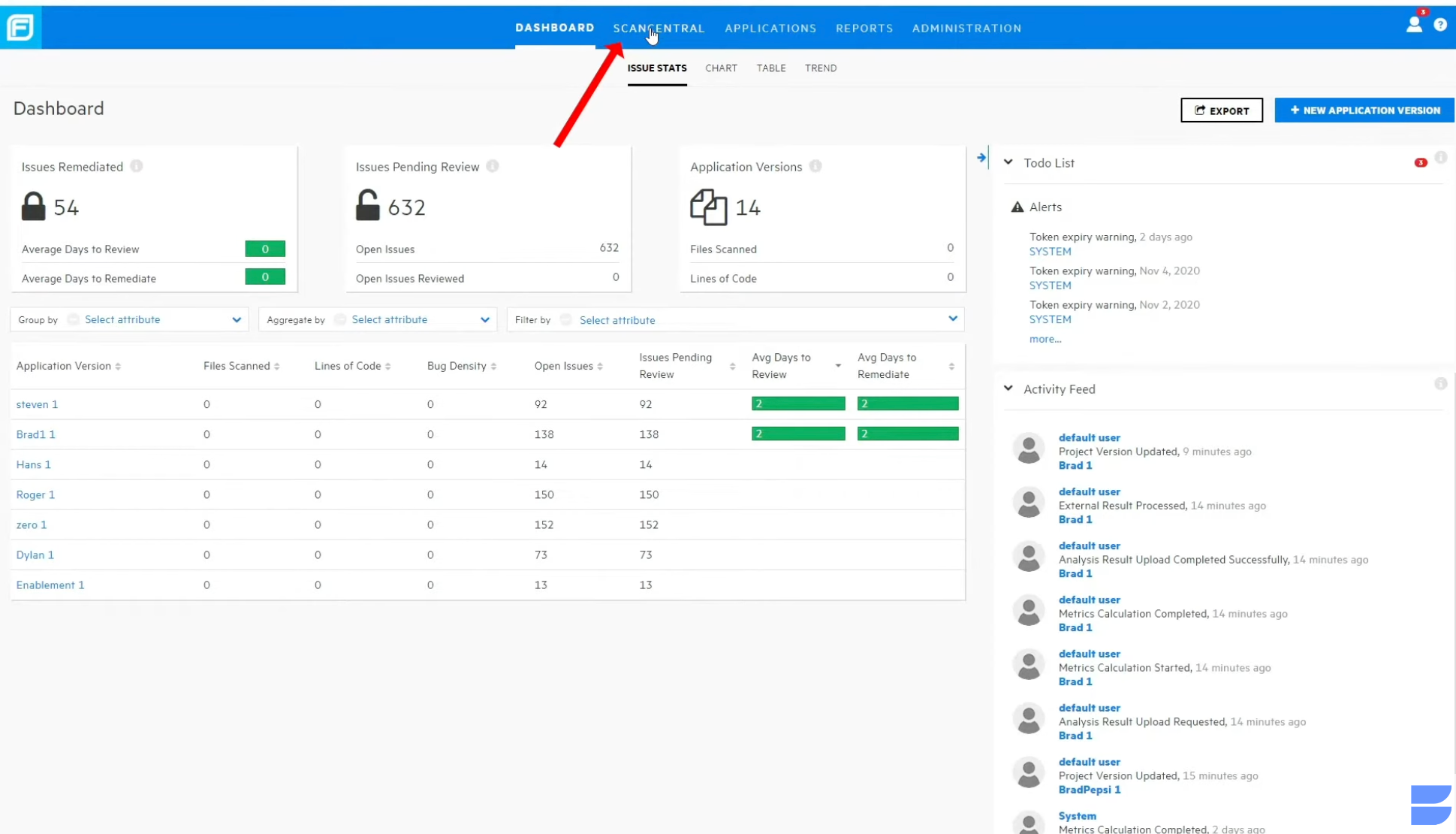
Overview:
Fortify WebInspect by OpenText is a dynamic application security testing (DAST) tool designed to detect vulnerabilities that traditional IAST tools might miss. It leverages functional security testing to enhance web application protection and supports horizontal scaling using Kubernetes to boost JavaScript scanning speeds.
The platform offers flexible deployment models, including on-premise, SaaS, and AppSec-as-a-Service, making it suitable for various enterprise environments. With built-in compliance templates and integrations, WebInspect is ideal for security teams needing robust, customizable application security assessments.
🔍 Features
● Detects redundant and duplicate pages to optimize scanning workflows
● Automatically generates macros to streamline test coverage
● Offers containerized delivery for modern infrastructure compatibility
● Scans multiple API protocols including REST, SOAP, OpenAPI, Swagger, Postman, GraphQL, and gRPC
● Integrates with OpenText tools such as Application Lifecycle Management and Quality Center for centralized control
📊 Pros & Cons
| 📈 Pros | 📉 Cons |
|---|---|
|
✅ Simultaneous crawling and auditing for faster vulnerability detection ✅ Customizable reporting for compliance and executive visibility ✅ Flexible deployment across cloud, hybrid, and on-prem environments |
❌ Requires technical expertise for effective configuration and use ❌ Steep learning curve to maximize platform efficiency ❌ Limited CI/CD integration may slow adoption in fast-paced DevOps environments |
Detectify


Overview:
Detectify is a cloud-based DAST tool designed to uncover vulnerabilities in publicly exposed web applications. It combines Surface Monitoring to detect changes and risks across subdomains and DNS assets with Application Scanning, which uses fuzzing techniques to find known web security flaws like SQL injection, XSS, and misconfigurations.
As one of the more lightweight DAST tools, Detectify is easy to set up and geared towards monitoring external-facing assets. However, it lacks native support for internal application scanning, complex authentication, and API security testing—making it less suitable for organizations with broader or more modern security requirements. To explore a more advanced approach to dynamic application security, see this detailed comparison of Detectify and modern DAST alternatives.
🔍 Features
● Continuously monitors domains and subdomains via DNS integrations such as AWS Route53, Azure, Cloudflare, and Google Cloud DNS.
● Uses fuzzing-based DAST scanning to identify common vulnerabilities like XSS, SQL injection, and insecure headers.
● Supports basic authentication and session cookies, but lacks advanced login handling or multi-factor workflows.
● Focused on external attack surface monitoring; does not support internal app or behind-the-firewall scanning.
● No native support for API security testing, GraphQL scanning, or automatic API schema handling.
📊 Pros & Cons
| 📈 Pros | 📉 Cons |
|---|---|
|
✅ Simple setup and fast onboarding for external web application scanning ✅ Continuous monitoring of public-facing domains for exposure ✅ Detects widely known vulnerabilities using automated DAST scanning |
❌ No native API testing or support for scanning internal applications ❌ Limited handling of complex authentication flows ❌ Generic remediation advice, not tailored to specific development frameworks ❌ Minimal reporting capabilities, lacking detailed compliance views ❌ Not ideal for scaling in larger or more complex security environments |
Preparing a list of DAST tools to evaluate on your modern applications?
Learn how Escape DAST can help you meet your compliance mandates quickly, reduce the load on your developers, and remediate vulnerabilities more effectively than ever
Examples of the legacy DAST tools
Qualys

Qualys' Web Application Scanning (WAS) is a cloud-based service with integrated API testing, focusing on identifying the OWASP Top 10 vulnerabilities. Its test suite spans legacy systems and cloud applications, and natively, Qualys only handles REST and SOAP APIs. The platform mostly addresses common issues such as authorization and authentication flaws, rate limiting, and injection vulnerabilities.
💡Explore a comprehensive comparison of Escape as a Qualys alternative here.
Features
- Can integrate with CI/CD pipelines and ITSM tools like Jira
- Has its own TruRisk scoring system to prioritize risks for your organization
- Can consolidate manual third-party pen testing data within the platform's automated scans
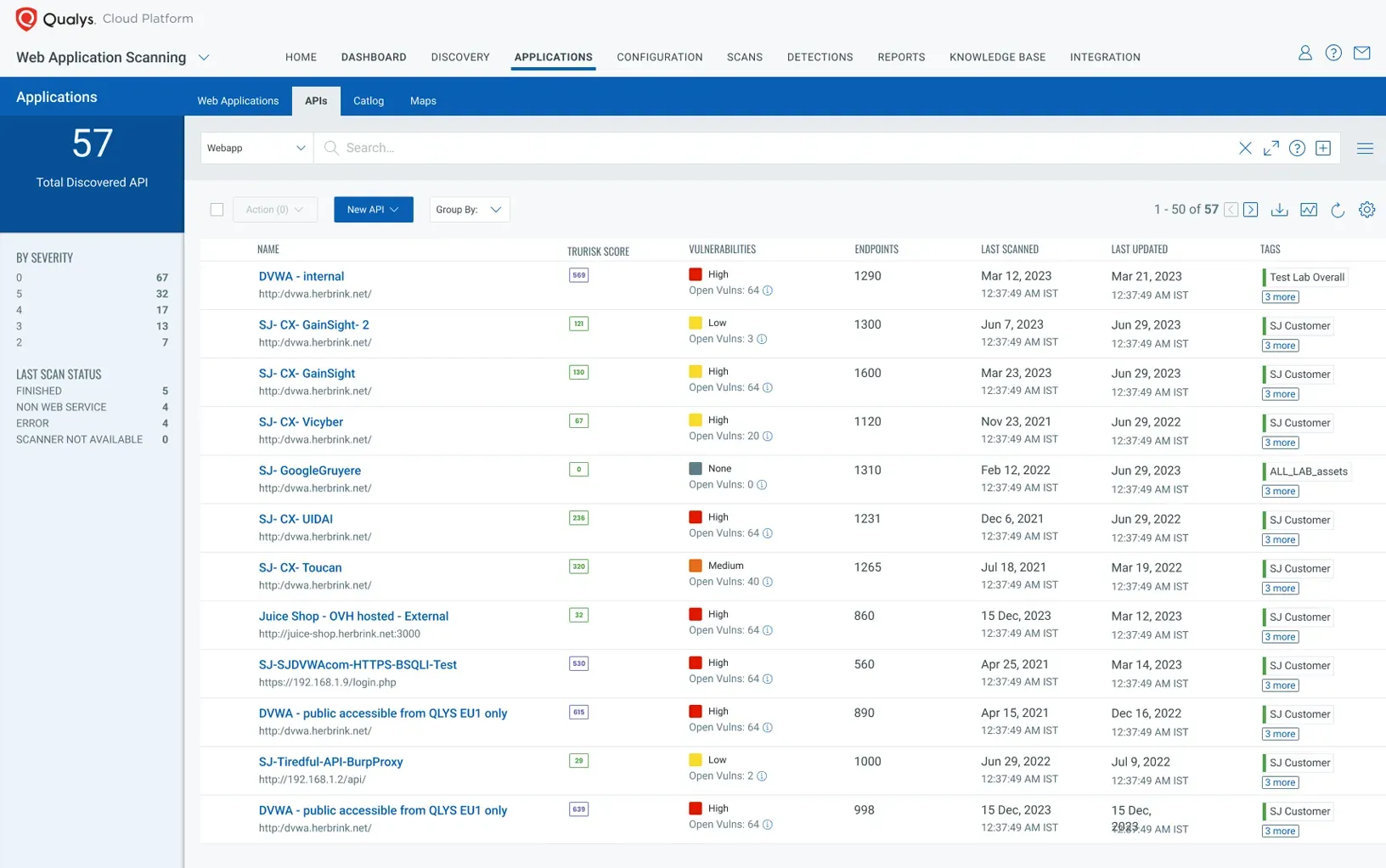
Rapid7 InsightAppSec

Rapid7's InsightAppSec is a legacy DAST scanner that scans applications hosted on a closed network with an optional on-premise engine that scans applications cloud engines cannot reach. Its "Universal Translator" technology means the tool can handle a range of protocols and application formats, and identifies vulnerabilities including SQL injections, XSS and CRSF. Rapid7 tests both applications and APIs, but it treats them the same, not considering the unique needs of API security.
💡Find a complete comparison between Escape and Rapid7 DAST here
Features
- Has crawl maps and scan logs, which detect authentication or access failures early in the scan
- Offers advanced scan settings
- Attack Replay allows teams to validate vulnerabilities
- Comes with pre-built default attack templates and custom attack templates
- Can leverage both cloud and on-prem scanning engines

Veracode

Veracode is a cloud-native platform that encompasses SAST, DAST, SCA and manual penetration testing, focusing on targeting web applications and APIs. Veracode automates security tasks and workflows throughout the Software Development Lifecycle (SDLC) and is a platform targeted toward teams who are looking to scan multiple applications simultaneously in their DAST.
Features
- Combines crawling and auditing
- Can integrate the platform with popular ticketing systems
- Veracode provides remediation guidance to interpret scan results
- Can schedule and automate scans, and the platform supports browser limitation and authentication
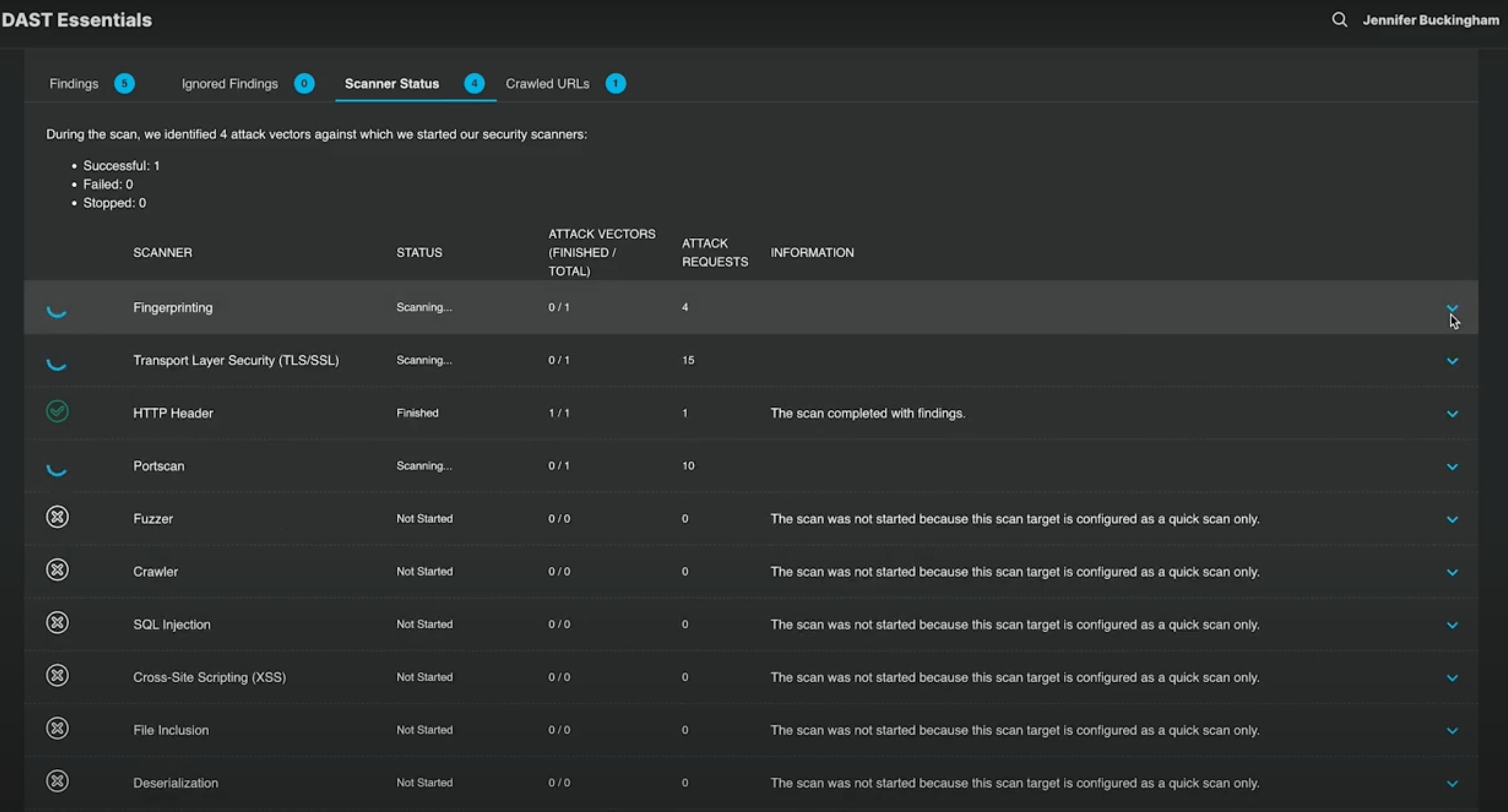
So, what makes a modern DAST Tool stand out? Key features to look for:
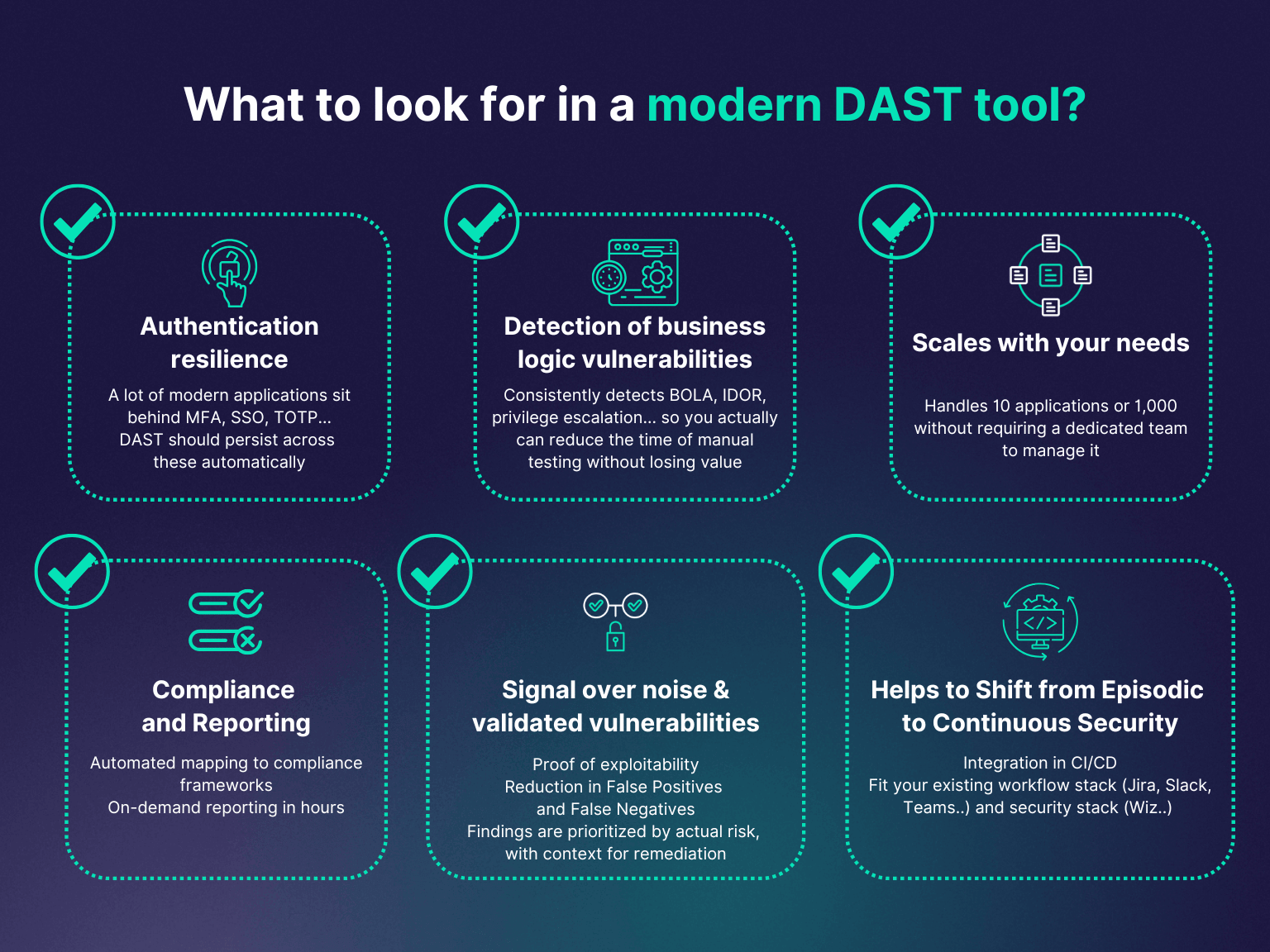
- Detection of business logic vulnerabilities: A DAST solution must consistently detect BOLA, IDOR, access control vulnerabilities, so you can actually trust the DAST vendor to find even the most complex vulnerabilities
- Scales with your needs: Handles 10 applications or 1,000 without requiring a dedicated team to manage it
- Real-time alerts and insights: As the DAST uncovers weaknesses, security teams should be immediately informed and provided with recommended remediations in order to optimize risk mitigation
- Signal over noise: DAST tools should reduce alert fatigue, not create it. Look for solutions that prioritize findings by actual risk, provide context for remediation, and eliminate false positives through intelligent validation, not just "dump" thousands of potential issues.
- Integration and workflows: The tool should fit your existing stack. Does it work with your issue tracker, send findings to Jira or Slack, and integrate with other security tools, like Wiz? Friction kills adoption.
- Integration into CI/CD: You need a DevSecOps DAST solution that integrates seamlessly with your CI/CD pipeline, automatically retests when code changes, and suggests to developers remediation code snippets tailored to their development framework. Ask: can it test daily releases without manual intervention?
- Authentication resilience: A lot of modern applications sit behind MFA, SSO, and rotating tokens. A platform should persist across these automatically, not collapse when a new tab is opened or when another user logs in.
Benefits of integrating a DAST tool into your security stack
DAST tools are crucial to a proactive security strategy in identifying application weaknesses from a front-end "outside-in" perspective. DAST is most often combined with static testing (SAST) as well as Software Composition Analysis (SCA) to ensure comprehensive security monitoring across all stages of the SDLC.
Having a DAST means that vulnerabilities can be remediated before an application goes live in production - and to cybercriminals, lowering the risk of a breach and making vulnerabilities cheaper to mend. Equally, DAST solutions can also help developers uncover general problems with the end-user experience, and crucially facilitate regulatory compliance.
Below are real-world use cases where DAST scanning delivers value:
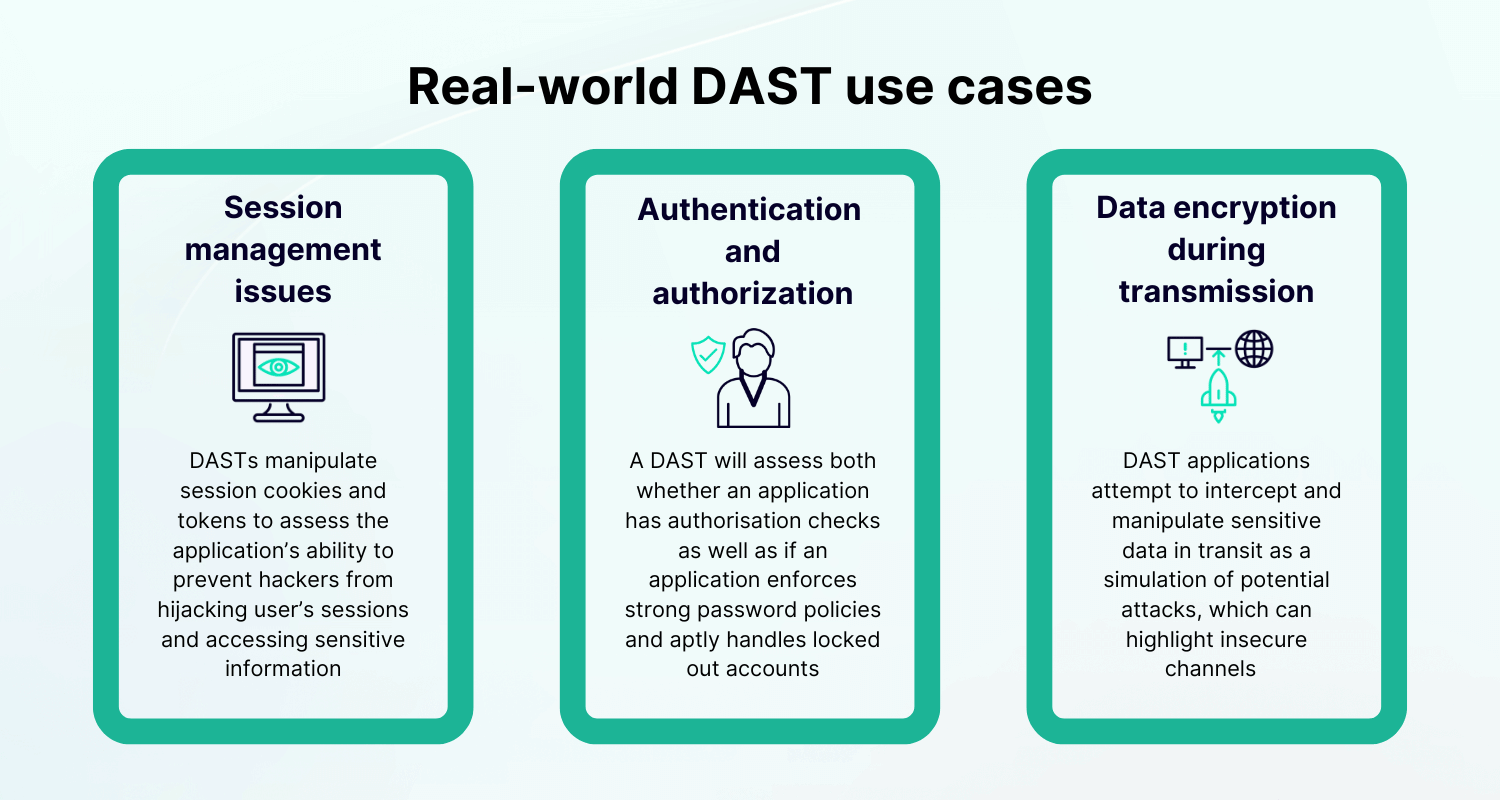
Conclusion: Choosing the right DAST tool for 2026
If you’re evaluating DAST solutions for modern stacks, especially APIs, SPAs, and CI/CD-native workflows, your priorities are clear: low false positives, real coverage of business logic flaws, and seamless integration into developer pipelines.
Legacy DAST scanners fall short. Tools like Escape are built from the ground up for today’s AppSec challenges - offering advanced detection, instant feedback in CI/CD, and real-world testing that matches how attackers operate.
See how Escape DAST compares to traditional DAST tools - book a live demo with a product expert who understands your architecture and security needs
Get a demoFAQ
💡 Want to discover more about DAST? Check out the following links:
- DAST is dead, why Business Logic Security Testing takes center stage
- We benchmarked DAST products, and this is what we learned
- The Elephant in AppSec Podcast⎥ Lack of effective DAST tools⎥ Aleksandr Krasnov (Meta, Thinkific, Dropbox)
- Reinventing API security: Why Escape is better than traditional DAST tools
- Escape DAST - Your Detectify Alternative

